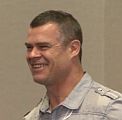DESIGN WITH NATURE TO CREATE LIVEABLE COMMUNITIES AND PROTECT STREAM HEALTH: “In the mid-1990s, I embarked on applied research that has defined my career with the District of North Vancouver. UBC’s Hans Schreier inspired me,” stated Richard Boase, career environmental champion within local government in the Metro Vancouver region

“When I look back at our history, I think wow, how did we do so much applied research. We had a need and Hans Schreier had grad students who were interested in doing the research. Win-win,” stated Richard Boase. “This research was in pursuit of making changes to the fabric of our urbanized areas. I was so encapsulated by what I saw around me, and the need for change, that my mind was always racing. And I needed to find ways to do research into what we were talking about.”










